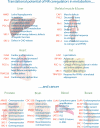Minireview: Evolution of NURSA, the Nuclear Receptor Signaling Atlas
- PMID: 19423650
- PMCID: PMC2691684
- DOI: 10.1210/me.2009-0135
Minireview: Evolution of NURSA, the Nuclear Receptor Signaling Atlas
Erratum in
- Mol Endocrinol. 2009 Sep;23(9):1522
Abstract
Nuclear receptors and coregulators are multifaceted players in normal metabolic and homeostatic processes in addition to a variety of disease states including cancer, inflammation, diabetes, obesity, and atherosclerosis. Over the past 7 yr, the Nuclear Receptor Signaling Atlas (NURSA) research consortium has worked toward establishing a discovery-driven platform designed to address key questions concerning the expression, organization, and function of these molecules in a variety of experimental model systems. By applying powerful technologies such as quantitative PCR, high-throughput mass spectrometry, and embryonic stem cell manipulation, we are pursuing these questions in a series of transcriptomics-, proteomics-, and metabolomics-based research projects and resources. The consortium's web site (www.nursa.org) integrates NURSA datasets and existing public datasets with the ultimate goal of furnishing the bench scientist with a comprehensive framework for hypothesis generation, modeling, and testing. We place a strong emphasis on community input into the development of this resource and to this end have published datasets from academic and industrial laboratories, established strategic alliances with Endocrine Society journals, and are developing tools to allow web site users to act as data curators. With the ongoing support of the nuclear receptor and coregulator signaling communities, we believe that NURSA can make a lasting contribution to research in this dynamic field.
Figures


References
-
- Lander ES, Linton LM, Birren B, Nusbaum C, Zody MC, Baldwin J, Devon K, Dewar K, Doyle M, FitzHugh W, Funke R, Gage D, Harris K, Heaford A, Howland J, Kann L, Lehoczky J, LeVine R, McEwan P, McKernan K, Meldrim J, Mesirov JP, Miranda C, Morris W, Naylor J, et al. 2001 Initial sequencing and analysis of the human genome. Nature 409:860–921 - PubMed
-
- O'Donovan C, Apweiler R, Bairoch A 2001 The human proteomics initiative (HPI). Trends Biotechnol 19:178–181 - PubMed
-
- Venter JC, Adams MD, Myers EW, Li PW, Mural RJ, Sutton GG, Smith HO, Yandell M, Evans CA, Holt RA, Gocayne JD, Amanatides P, Ballew RM, Huson DH, Wortman JR, Zhang Q, Kodira CD, Zheng XH, Chen L, Skupski M, Subramanian G, Thomas PD, Zhang J, Gabor Miklos GL, Nelson C, et al. 2001 The sequence of the human genome. Science 291:1304–1351 - PubMed
-
- Waterston RH, Lindblad-Toh K, Birney E, Rogers J, Abril JF, Agarwal P, Agarwala R, Ainscough R, Alexandersson M, An P, Antonarakis SE, Attwood J, Baertsch R, Bailey J, Barlow K, Beck S, Berry E, Birren B, Bloom T, Bork P, Botcherby M, Bray N, Brent MR, Brown DG, Brown SD, et al. 2002 Initial sequencing and comparative analysis of the mouse genome. Nature 420:520–562 - PubMed
-
- Margolis RN, Evans RM, O'Malley BW 2005 The Nuclear Receptor Signaling Atlas: development of a functional atlas of nuclear receptors. Mol Endocrinol 19:2433–2436 - PubMed
Publication types
MeSH terms
Substances
Grants and funding
LinkOut - more resources
Full Text Sources
Other Literature Sources
Miscellaneous

